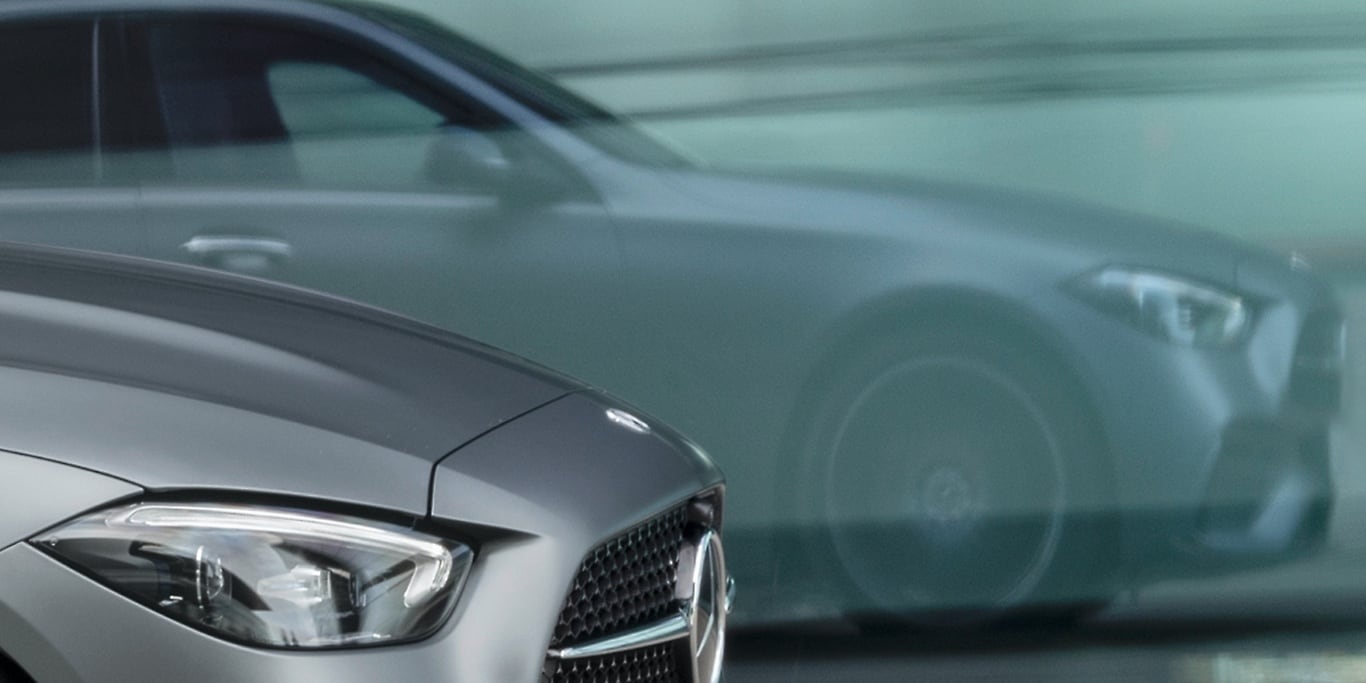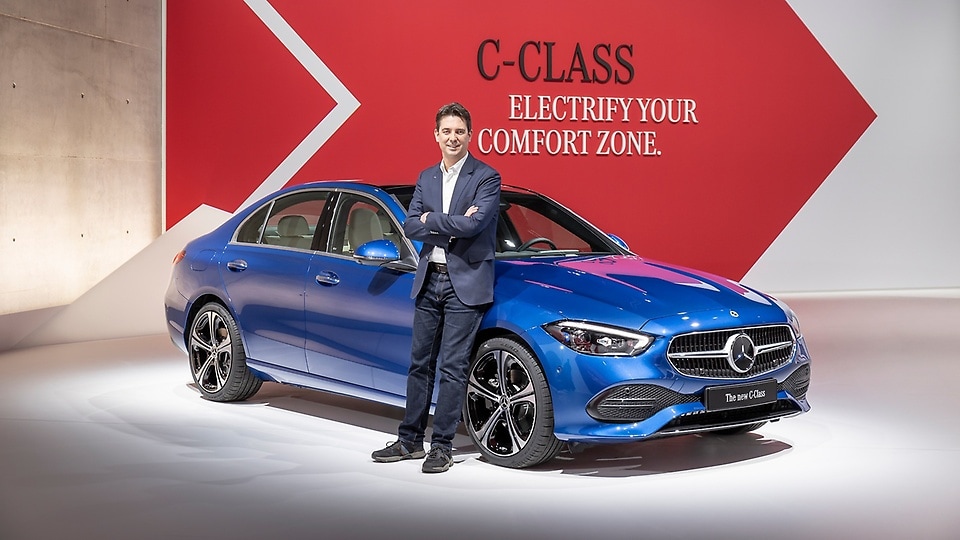Whoever switched a combustion engine for a battery-electric vehicle knows: It’s different. Is the car really running? Will I get home with 20 percent battery capacity? And where do I charge? It’s not only the driving experience missing the engine sound, but also the well-planned refuelling at the charging station which make this switch a real change. For those who would like to become familiar with the benefits of recuperation first, while not missing the engine sound, may take a first step towards electric mobility with the mild hybrid technology. Anyone, though, who wants to drive major parts of daily routes fully electric makes the right choice with the plug-in hybrid technology. Both drive technologies are available in the new Mercedes-Benz C-Class. Two experts from the passenger car development explain their functions and advantages.
Easy Tech: The electrification of the new Mercedes-Benz C-Class

The new C-Class: Combustion Engines Electrified.
Every engine variant of the new C-Class is already electrified, as either mild hybrid or plug-in hybrid. This makes the C-Class the first Mercedes model series to be completely electrified. How do these drive technologies work in the new C-Class? And what advantages do they offer with regard to range, driving dynamics and efficiency?
10 min reading time
Content
- How does the plug-in hybrid technology work?
- What are the benefits of the plug-in hybrid technology?
- How does recuperation work in a plug-in hybrid?
- How does the mild hybrid technology work?
- What are the benefits of mild hybrids?
- How does recuperation work in a mild hybrid?
- What is the effect of load point shifting?
- What is meant by coasting?
- “Electric first” reaching from electrified combustion engine to all-electric luxury saloon
How does the plug-in hybrid technology work?
“The plug-in hybrid C-Class is not only driven by a four-cylinder petrol or diesel engine, but also by a powerful 95 kW electric motor receiving energy from a high-voltage lithium-ion battery”, explains Matthias Klöpfer. He and his team are part of the fourth generation plug-in hybrid drivetrain development. This fourth generation is particularly characterised by the compact integration of the power electronics into the transmission housing and the more powerful drive system.
The high-voltage battery consists of 96 cells providing a total capacity of 25.4 kWh. It can be charged at a household-socket or charging station with either direct current (DC, optional) or alternating current (AC, standard). “DC charging with up to 55 kW at a high power charging station takes about 30 minutes to completely recharge the battery. AC charging with 11 kW takes about two hours. Thus a plug-in hybrid is suitable for daily use“, says Matthias Klöpfer.


What are the benefits of the plug-in hybrid technology?
Matthias Klöpfer is particularly proud of the all-electric range of around 100 km (WLTP¹). Because this makes electric driving possible for many, if not all, everyday journeys. For the new plug-in hybrid generation, driving with zero local emissions has priority, which is why the driving mode ELECTRIC is set as standard. The combustion engine is available for high speeds or long distance drives. Thus, a plug-in hybrid meets both demands and the question of whether you’ll get home with 20 percent battery capacity is no longer necessary. “No matter if freezing or summerlike temperatures are a strain on the air conditioning, or if you’re suddenly stuck in traffic: with a hybrid you always have a comforting range as you can rely on the combustion engine any time. “
Even more comfort

Compared to the previous model, the battery is now positioned lower in the rear, making the step in the boot obsolete and loading much easier. Furthermore, the electric motor with 95 kW (129 hp, 440 Nm of maximum torque) is more dynamic: it provides the full electric power up to 140 km/h, at this point electric driving is capped softly. “The 95 kW are a lot of fun! Not only on the Autobahn, but also at the fuel station. The greatest fuel savings
How does recuperation work in a plug-in hybrid?
Energy is released during braking, when driving downhill or approaching a vehicle up ahead. The electric motor recovers this braking energy by converting (“recuperating”) it into electricity that is used to recharge the high-voltage battery. The higher a battery’s capacity, the more recovered electricity can a battery receive. The energy recovery capacity of the C-Class is up to 100 kW, enabling the recuperation of a maximum of braking energy.
In recuperation mode DAUTO, the car automatically defines the energy recovery rate based on the traffic situation. If one prefers to recuperate manually can do so by choosing from three different recuperation modes (in all driving modes except SPORT): D+, D and D-.
“This comes with the advantage that, as a driver, I’m able to recuperate much more forward-looking in certain situations”, explains Matthias Klöpfer. Especially for routes on the Autobahn or winding roads, he recommends recuperation mode D-: “As soon as I take my foot off the accelerator, the C-Class slows down purely electric. To such an extent, that I don’t need to brake. This enhances my driving comfort and at higher speeds, I can recover more energy to recharge the battery. Overall, this makes a plug-in hybrid very efficient.”
Apart from the plug-in hybrid technology, combustion engines in the new C-Class are electrified with the so-called mild hybrid technology. As with the plug-in hybrid technology, the focus is on the combination of a combustion engine with an electric motor in order to reduce fuel consumption and CO₂ emissions.
How does the mild hybrid technology work?
“The mild hybrid technology electrifies combustion engines. As a result, the new models of the C-Class family offer even better driving dynamics while at the same time consuming much less fuel,” says Christof Kühner. At Mercedes-Benz, he is in charge of overall vehicle testing for the C-Class for which the new four-cylinder engines are available as mild hybrids.
The C-Class is offered with the newly developed M 254 four-cylinder petrol engine as well as with the updated OM 654 four-cylinder diesel engine. For the first time, both of these engines are now equipped with an integrated starter generator (ISG) and a 48-volt vehicle electrical system. “From the very first rotation on, the ISG provides 15 kW of additional electric power.”
In concrete terms, this means that every Mercedes that is equipped with an ISG and a 48-volt vehicle electrical system is a mild hybrid. Unlike the plug-in hybrid technology, the electric motor in a mild hybrid does not drive the car, but instead assists the combustion engine at low engine speeds, such as when starting or accelerating.
What are the benefits of mild hybrids?
The new four-cylinder engines of the C-Class use integrated starter generators of the second generation. This ISG combines the starter and the generator into a high-performance electric motor that is located between the combustion engine and the transmission. This electric motor is connected to a 48-volt battery that supplies the vehicle electrical system and the electric machine with electricity. By combining the ISG with a 48-volt vehicle electrical system, it not only optimizes driving dynamics, but also efficiency.
In both the M 254 four-cylinder petrol engine (190 kW/258 hp, 400 Nm of maximum torque) and the OM 654 four-cylinder diesel engine (195 kW/265 hp, 550 Nm of maximum torque), an additional 15 kW of electric power and 200 newton-metres of torque are temporarily provided. “Thus both engine variants are quickly provided with more power and torque,” says Christof Kühner. “This has a very positive effect when a vehicle starts up or accelerates.”
A positive effect that also applies to fuel savings. Despite improved driving dynamics, mild hybrids can achieve fuel savings and CO₂ reductions that, previously, could only be attained by plug-in hybrid models. This is made possible by the 48-volt battery, which can store energy and supply it to the electric motor. Thus enabling the system to offer typical hybrid features, such as recuperation, load point shift, coasting, and an almost unnoticeable restart of the engine in the start/stop function.
How does recuperation work in a mild hybrid?
Energy is released during braking or when approaching a vehicle up ahead. The ISG recovers this energy by converting (“recuperating”) it into electricity that is used to recharge the 48-volt battery. “The 48-volt battery stores the recovered energy and supplies it to the electric motor. This way, the electric motor can provide the combustion engine with up to 15 kW for a more dynamic acceleration,” explains Christof Kühner.
What is the effect of load point shifting?
The mild hybrid technology also has a positive effect on the engine load. “Because the ISG can shift the load points at low engine speeds by providing the engine with an electric boost, the combustion engine always operates in convenient engine characteristics.” This reduces fuel consumption, “especially in urban driving when I have to continuously restart the engine in stop-and-go traffic and accelerate from a standstill, thus at low engine speeds.”
What is meant by coasting?
Another feature that helps to actively save fuel is known as coasting. If the driver takes his or her foot off the gas pedal when the ECO drive program is activated, the combustion engine is uncoupled from the drive system and switches off completely. “It really makes the driver feel as if the vehicle is coasting smoothly along the road.” The engine restart from the coasting mode is barely noticeable because the starter generator brings the combustion engine to synchronous speed very quickly and evenly. This makes the starting procedure even quieter. The same applies to restarting the engine with the start/stop function, so that the driver hardly notices the restart procedure. “Pure driving comfort,” says Christof Kühner.
“Electric first” reaching from electrified combustion engines to an all-electric luxury saloon
The new four-cylinder engines in the C-Class have a modular structure and are part of the Family of Modular Engines (FAME). The advantage of FAME is that the base engines can be combined with the mild hybrid as well as with the plug-in hybrid drivetrains. This also helps to flexibly produce vehicles with different drivetrains on a single line. It also follows the approach to cover the entire range of electrification in order to meet the variety of customer needs.
1. Mild Hybrids: Electrified combustion engines with ISG and 48-volt vehicle electrical system merely supporting the combustion engine. For example in the new C-Class.
2. Plug-in Hybrids: Electrified combustion engines which are additionally driven by an electric motor that can be charged at a charging station. Partial routes can be driven fully electric. For example in the compact car segment (from A-Class to CLA Shooting Brake), the new C-Class, the E-Class, the GLE or the S-Class.
3. Mercedes-EQ: All-electric cars which are exclusively driven by one or several electric motors. For example the EQA, EQB, EQC or EQS.
So, whoever may not want (or could) immediately switch their combustion engine for an all-electric Mercedes-EQ, finds ideal drive technologies to bridge the gap in the new C-Class as mild hybrid or plug-in hybrid. The start of sales for mild hybrids was March 30th. From June 2021, the C-Class Saloon and Estate will be available at the dealerships, followed by the first C-Class plug-in hybrid soon after. And those who already clicked the switch to electric mobility can look forward to what Mercedes-EQ has in stock this year – reaching from the compact EQA to the luxury saloon EQS.



¹The stated figures are the measured “WLTP CO₂ figures” in accordance with Article 2 No. 3 Implementing Regulation (EU) 2017/1153. The fuel consumption figures were calculated based on these figures. Power consumption and range were determined on the basis of Commission Regulation (EU) No. 2017/1151. All figures shown are provisional. The vehicle is not on sale yet.
***The stated figures were determined in accordance with the prescribed measuring method. These are the NEDC CO2 figures according to Article 2 No. 1 Implementing Regulation (EU) 2017/1153. The fuel consumption figures were calculated on the basis of these figures. Electric energy consumption was determined on the basis of Regulation (EC) No. 692/2008.


















